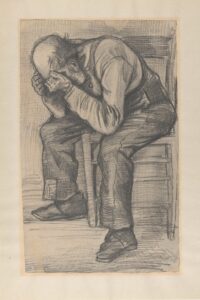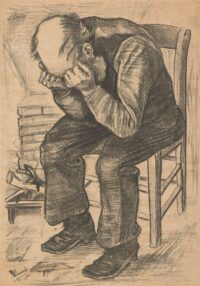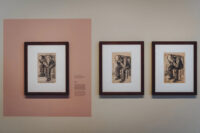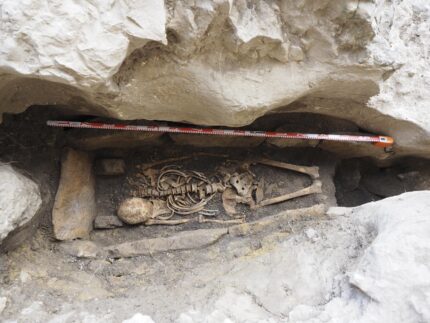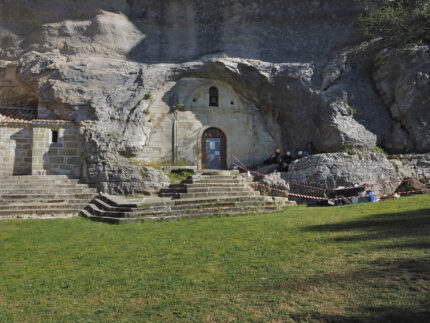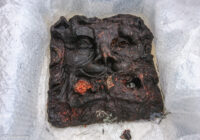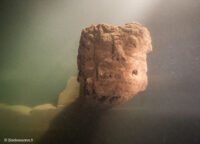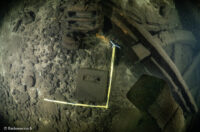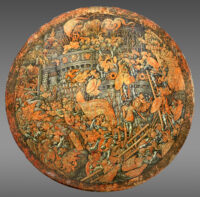 The Philadelphia Museum of Art has agreed to return a 16th century shield that was looted by Nazis during World War II to the Czech Republic. The pageant shield, elaborately decorated with a scene of Publius Cornelius Scipio Africanus capturing what is now Cartagena in southern Spain during the Second Punic War, was created by Girolamo di Tommaso da Treviso around 1535 out of wood, linen, gesso, gold and pigment. It was part of the collection of Konopiště Castle in Benešov, about 25 miles southeast of Prague, that was stripped bare during the Nazi occupation of Czechoslovakia. It will now go back on display in the castle 80 years after it was stolen.
The Philadelphia Museum of Art has agreed to return a 16th century shield that was looted by Nazis during World War II to the Czech Republic. The pageant shield, elaborately decorated with a scene of Publius Cornelius Scipio Africanus capturing what is now Cartagena in southern Spain during the Second Punic War, was created by Girolamo di Tommaso da Treviso around 1535 out of wood, linen, gesso, gold and pigment. It was part of the collection of Konopiště Castle in Benešov, about 25 miles southeast of Prague, that was stripped bare during the Nazi occupation of Czechoslovakia. It will now go back on display in the castle 80 years after it was stolen.
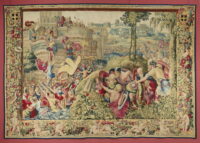 The complex battle scene of the Roman army assaulting the rounded crenelated towers of the city was based on a tapestry from a series depicting scenes from the life of Scipio designed by Giulio Romano for King Francis I of France. Romano drew the cartoons for the tapestries in 1531-1533. The tapestries were then woven in Brussels and sent to the king in 1535. They fell victim to the French Revolution’s orgy of anti-monarchical iconoclasm in 1797, destroyed to harvest the gold and silver threads used in the weaving. Copies of the Scipio tapestries commissioned by Louis XIV in 1688 survived the Revolution and are now in the Louvre.
The complex battle scene of the Roman army assaulting the rounded crenelated towers of the city was based on a tapestry from a series depicting scenes from the life of Scipio designed by Giulio Romano for King Francis I of France. Romano drew the cartoons for the tapestries in 1531-1533. The tapestries were then woven in Brussels and sent to the king in 1535. They fell victim to the French Revolution’s orgy of anti-monarchical iconoclasm in 1797, destroyed to harvest the gold and silver threads used in the weaving. Copies of the Scipio tapestries commissioned by Louis XIV in 1688 survived the Revolution and are now in the Louvre.
(Wee digression: Cartagena was founded by Hasdrubal Barca, Hannibal’s younger brother, in 228 B.C. at the site of an earlier Iberian settlement. The Punic name for Carthage was Qart Hadasht, meaning New City, because it was founded by Phoenician colonists from Tyre (the old city). Hasdrubal named his foothold in Spain Qart Hadasht too. It was Scipio Africanus who renamed it Carthago Nova after his conquest of it in 209 B.C. to differentiate it from the original, so he basically copyedited Hasdrubal, correcting New City into the more precise New New City.)
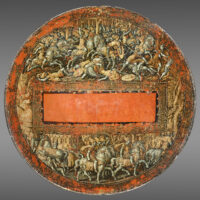 Twenty-four inches in diameter, the round shield was made for ceremonial purposes, and the subject matter may have been chosen in homage to Holy Roman Emperor Charles V who in 1535 captured Tunis, née Carthage, from the Ottoman Empire. Charles V’s victory over the Ottoman corsairs was analogized to Scipio’s defeat of Carthage, and upon his return, the Emperor was feted all over Italy.
Twenty-four inches in diameter, the round shield was made for ceremonial purposes, and the subject matter may have been chosen in homage to Holy Roman Emperor Charles V who in 1535 captured Tunis, née Carthage, from the Ottoman Empire. Charles V’s victory over the Ottoman corsairs was analogized to Scipio’s defeat of Carthage, and upon his return, the Emperor was feted all over Italy.
The shield was not presented to Charles V. It stayed in Italy for more than three centuries. In the 1700s it was in the Castello del Catajo outside Padua, part of the vast collection of arms and armature amassed by the marquess Tommaso degli Obizzi. He was the last to hold the title, and he left his all of his family’s wealth and possessions to the House of Este. Those lands, estates and collections were absorbed into the Ducal House of Austria-Este, the fruit of a marriage between Archduke Ferdinand of Austria, son of Holy Roman Empress Maria Theresa, and Maria Beatrice Este, last surviving heir of the Este family.
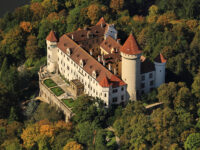 That wealth paid for Konopiště Castle. Originally built in the late 13th century, the castle was refashioned into a Baroque palace in the 1730s and 40s, but had fallen into disrepair by the end of the 19th century. Archduke Franz Ferdinand of Austria, whose assassination in 1914 would set alight the powder keg that exploded into World War I, bought the castle in 1887 with money he inherited after the death of the last scion of the Austria-Este ducal house. That inheritance included the Obizzi-Este collection of arms and armature, the third largest collection of armory and medieval weapons in Europe.
That wealth paid for Konopiště Castle. Originally built in the late 13th century, the castle was refashioned into a Baroque palace in the 1730s and 40s, but had fallen into disrepair by the end of the 19th century. Archduke Franz Ferdinand of Austria, whose assassination in 1914 would set alight the powder keg that exploded into World War I, bought the castle in 1887 with money he inherited after the death of the last scion of the Austria-Este ducal house. That inheritance included the Obizzi-Este collection of arms and armature, the third largest collection of armory and medieval weapons in Europe.
The collection, including the da Treviso shield, was installed in Konopiště Castle in 1896 where it remained even after the demise of the Austro-Hungarian Empire birthed Czechoslovakia. Then came the Second World War.
In 1939 the Nazi government annexed the part of Czechoslovakia where Konopiště was located, and in 1943 the German army (Wehrmacht) confiscated the Konopiště Castle armor collection, including the shield, and took it to Prague to be housed in a new military museum. However, Adolf Hitler’s arms and armor curator, Leopold Ruprecht, soon skimmed off the cream of the collection, inventoried it, and dispatched it to Vienna, intending the best for Hitler’s planned mega-museum in Linz, Austria. At the end of the war, large groups of Konopiště objects were recovered by the Allies and returned to Czech authorities in 1946, but among 15 objects that remained missing was a shield whose description was similar to the pageant shield.
Thirty years later, the pageant shield was bequeathed to the Philadelphia Museum of Art by avid collector of medieval arms Carl Otto Kretzschmar von Kienbusch. Its ownership history was threadbare and previous attempts to determine whether it was indeed the looted Konopiště Castle shield were inconclusive.
Since 2016, the museum has been collaborating with historians in the Czech Republic to evaluate the history and provenance of the Italian pageant shield. Recent research identified pre-WWII inventories which, in tandem with a photograph, dated to around 1913, showing the museum’s shield as displayed at Konopiště Castle provided by the museum, persuasively identify the shield as the one illegally taken from Konopiště Castle by the Nazis and never restituted. Based on these revelations, the Board of Trustees of the Philadelphia Museum of Art unanimously concluded that rightful title in the work belonged to the Czech Republic and approved the return of the armor at its meeting of June 17, 2021.
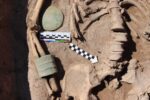 The remains of a woman buried with a rich array of heavy bronze jewelry have been unearthed in what is now the Republic of Khakassia, southern Siberia. The intact grave was discovered in the Askiz-17 burial ground and dates to the 8-10th century B.C.
The remains of a woman buried with a rich array of heavy bronze jewelry have been unearthed in what is now the Republic of Khakassia, southern Siberia. The intact grave was discovered in the Askiz-17 burial ground and dates to the 8-10th century B.C.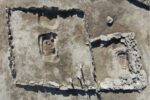 centuries earlier. Only 30 inches deep, the pit managed to avoid being damaged or destroyed by the construction of highways and railroads that has taken a heavy toll on the visible structures of the prehistoric burial ground.
centuries earlier. Only 30 inches deep, the pit managed to avoid being damaged or destroyed by the construction of highways and railroads that has taken a heavy toll on the visible structures of the prehistoric burial ground.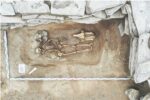 horned mammal — were tidily placed to the side of her left foot as funerary offerings. The broken blade of a bronze knife was laid next to them. A large round pottery vessel with an ornamented rim was placed next to her head. It is in fragments, smashed over time by the stone filling of the burial pit.
horned mammal — were tidily placed to the side of her left foot as funerary offerings. The broken blade of a bronze knife was laid next to them. A large round pottery vessel with an ornamented rim was placed next to her head. It is in fragments, smashed over time by the stone filling of the burial pit. articulated in their original anatomical order. It is what her bones are wearing that identifies her as part of the Karasuk culture, skilled metal workers renown for their high-quality bronze cast in wax.
articulated in their original anatomical order. It is what her bones are wearing that identifies her as part of the Karasuk culture, skilled metal workers renown for their high-quality bronze cast in wax.To each side of the woman’s skull were 3 temple rings; two triangle plates were next to her head.
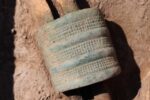 Archaeologists believe this was a custom-made funerary set, not jewelry the woman would have worn during her lifetime. There are no signs of wear and tear, not even the small scratches you’d expect from any kind of use at all. The sheer weight of the jewelry would have made them uncomfortable and unwieldy to wear under regular ambulatory circumstances.
Archaeologists believe this was a custom-made funerary set, not jewelry the woman would have worn during her lifetime. There are no signs of wear and tear, not even the small scratches you’d expect from any kind of use at all. The sheer weight of the jewelry would have made them uncomfortable and unwieldy to wear under regular ambulatory circumstances.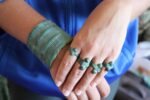 All pieces from the small buttons, which once adorned burial clothes that have long-since decomposed, to the massive bracelet are made in the same artistic style typical of the the Minusinsk Basin in the Late Bronze Age. They were likely cast to order from one foundry. Her entire outfit, clothes and jewels, was a matched set created by a single master bronzesmith to send the deceased off in a style befitting her wealth and high status.
All pieces from the small buttons, which once adorned burial clothes that have long-since decomposed, to the massive bracelet are made in the same artistic style typical of the the Minusinsk Basin in the Late Bronze Age. They were likely cast to order from one foundry. Her entire outfit, clothes and jewels, was a matched set created by a single master bronzesmith to send the deceased off in a style befitting her wealth and high status.